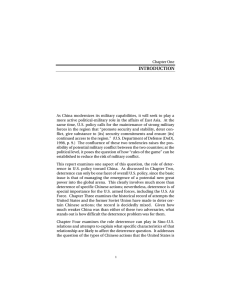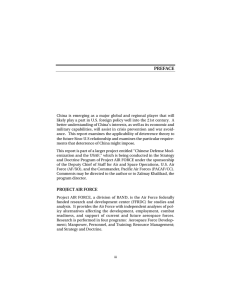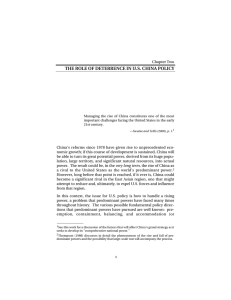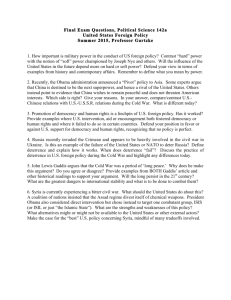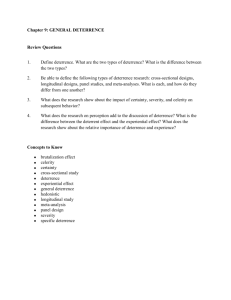DETERRENCE IN THE CONTEXT OF SINO-U.S. RELATIONS
advertisement
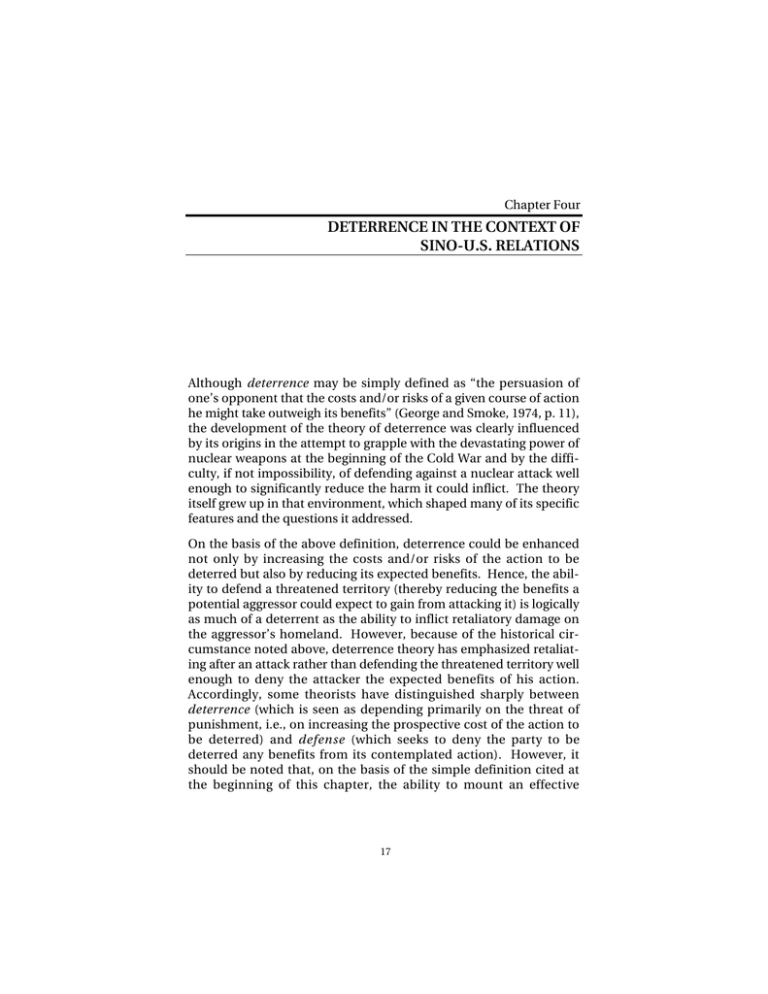
Chapter Four DETERRENCE IN THE CONTEXT OF SINO-U.S. RELATIONS Although deterrence may be simply defined as “the persuasion of one’s opponent that the costs and/or risks of a given course of action he might take outweigh its benefits” (George and Smoke, 1974, p. 11), the development of the theory of deterrence was clearly influenced by its origins in the attempt to grapple with the devastating power of nuclear weapons at the beginning of the Cold War and by the difficulty, if not impossibility, of defending against a nuclear attack well enough to significantly reduce the harm it could inflict. The theory itself grew up in that environment, which shaped many of its specific features and the questions it addressed. On the basis of the above definition, deterrence could be enhanced not only by increasing the costs and/or risks of the action to be deterred but also by reducing its expected benefits. Hence, the ability to defend a threatened territory (thereby reducing the benefits a potential aggressor could expect to gain from attacking it) is logically as much of a deterrent as the ability to inflict retaliatory damage on the aggressor’s homeland. However, because of the historical circumstance noted above, deterrence theory has emphasized retaliating after an attack rather than defending the threatened territory well enough to deny the attacker the expected benefits of his action. Accordingly, some theorists have distinguished sharply between deterrence (which is seen as depending primarily on the threat of punishment, i.e., on increasing the prospective cost of the action to be deterred) and defense (which seeks to deny the party to be deterred any benefits from its contemplated action). However, it should be noted that, on the basis of the simple definition cited at the beginning of this chapter, the ability to mount an effective 17 18 Deterrence Theory and Chinese Behavior defense—thereby demonstrating the capability to deny the aggressor the prize that he seeks—can itself function as a deterrent.1 This ambiguity reflects the origins of deterrence theory in the novel problem that the Soviet acquisition of strategic nuclear warheads and delivery vehicles posed, against which no effective defense was considered to be possible. Hence, deterrence by means of punishment became the only option for addressing the new threat. With this was coupled the perception that a conventional defense of Western Europe was either impossible or ruinously expensive (or would result, in any case, in unacceptable levels of destruction to the nations on whose territories the battle would have to be fought).2 In this context, the predominance of punishment over defense (or denial) as a means of effecting deterrence is not surprising. Deterrence theory also developed in the context of U.S. containment policy, which sought to prevent any further expansion of Soviet control beyond the line the Red Army had reached in its advance on Germany. Thus, in principle at least, any Soviet military advance was to be deterred. 3 The problem became one of figuring out what kinds ______________ 1 Thus, Snyder begins by asserting: The central theoretical problem in the field of national security policy is to clarify and distinguish between the two central concepts of deterrence and defense. . . . Deterrence does not vary directly with our capacity for fighting wars effectively and cheaply; a particular set of forces might produce strong deterrent effects and not provide a very effective denial and damage-alleviating capability. Conversely, forces effective for defense might be less potent deterrents than other forces which were less efficient for holding territory and which might involve extremely high war costs if used. (Snyder, 1961, pp. 3–4; emphasis in the original.) Later, however, Snyder does recognize the possibility of deterrence by denial: It is useful to distinguish between deterrence which results from capacity to deny territorial gains to the enemy, and deterrence by the threat and capacity to inflict nuclear punishment. Denial capabilities—typically, conventional ground, sea, and tactical air forces—deter chiefly by their effect on . . . the aggressor’s . . . estimate of the probability of gaining his objective. Punishment capabilities—typically, strategic nuclear power for either massive or limited retaliation—act primarily on . . . the aggressor’s estimate of possible costs, and may have little effect on his chances for territorial gain. (Snyder, 1961, pp. 14–15). 2 The deterrence of a Soviet strategic nuclear attack on the United States, on the one hand, and of a Soviet conventional attack on Western Europe, on the other, became the archetypes of “direct” and “extended” deterrence (using the terminology of Huth, 1988, pp. 16–18.) 3 Of course, things did not always work out this way in practice, most noticeably in the case of Korea; a statement by then–Secretary of State Dean Acheson in early 1950 describing the U.S. “defense perimeter” in case of general war in the Asia-Pacific Deterrence in the Context of Sino-U.S. Relations 19 of threats could serve as credible deterrents, once the Soviet Union had broken the American monopoly on nuclear weapons and the ability to deliver them to intercontinental distances. In particular, the threat of nuclear retaliation against the Soviet Union—the heart of the Eisenhower-era doctrine of “massive retaliation”—became less credible once the Soviets could respond in kind, and it seemed to be limited to circumstances involving the highest stakes, e.g., the defense of Western Europe. It seems clear that any deterrence posture adopted toward China would differ in many important respects. First of all, there is the question of what the United States would be trying to deter. In the Soviet case, deterrence was directed primarily against any future territorial expansion by military means. Although the formative experiences (e.g., the Communist coup d’état in Czechoslovakia, the Berlin blockade, and the North Korean invasion of South Korea) were not actual Soviet military invasions, they did involve the threat or actual use of military forces. The containment policy implied that territorial expansion was the threat to be dealt with and that blocking that expansion would put intolerable pressures on the Soviet regime, leading to its ultimate transformation or destruction.4 With respect to China, the overall emphasis would be somewhat different. The initial question is, to what extent does Chinese expansionism have to be deterred in the first place? On the one hand, the Chinese, unlike the Soviets, claim territories (Taiwan, the South China Sea region, and the Senkaku/Diaoyu islands) over which they do not exercise de facto control; with respect to these territories, the Chinese claim a right to use force. The U.S. position on the Taiwan issue—that it has “an abiding interest that any resolution be peace______________________________________________________________ region could have been interpreted as expressing a disinterest in the fate of the South Korean regime. See Tsou (1963), pp. 535–536. 4 In his famous article, George Kennan (writing anonymously) advocated “a policy of firm containment, designed to confront the Russians with unalterable counter-force at every point where they show signs of encroaching upon the interests of a peaceful and stable world.” This was not, however, a purely defensive policy of “holding the line and hoping for the best.” Instead, Kennan argued that, by following such a policy, the United States could increase enormously the strains under which Soviet policy must operate, . . . force upon the Kremlin a far greater degree of moderation and circumspection . . . , and in this way . . . promote tendencies which must eventually find their outline in either the break-up or the gradual mellowing of Soviet power. (“X” [Kennan], 1947, pp. 581–582.) 20 Deterrence Theory and Chinese Behavior ful” (DoD, 1998, p. 35)—implies an interest in deterring any Chinese threat or use of force against Taiwan. Hence, this is one case of possible Chinese territorial expansion that the United States might wish to deter militarily.5 With respect to the South China Sea, the United States has not taken any position regarding the overlapping claims of China, Taiwan, and the littoral states to various islands and sectors and has not taken any action to deter or counter unilateral actions by China (or any other claimant) to assert control over any of the disputed islands. Thus, in January 1974, the United States did not come to the aid of its foundering ally when the Chinese seized South Vietnamese–held islands of the Paracel (Xisha) group. Similarly, the United States did not react to the Chinese occupation of Philippine-claimed Mischief Reef in 1995. However, on June 16, 1995 (after the Chinese had built a permanent structure on Mischief Reef, also claimed by the Philippines), then– Assistant Secretary of Defense for International Security Affairs Joseph Nye said that, if military action in the Spratlys interfered “with freedom of the seas, then we would be prepared to escort and make sure that free navigation continues.” 6 Given such a policy, the United States might, at some point in the future, seek to deter Chinese military action in the South China Sea on the grounds that it would interfere with navigation along the vital sea routes between the Middle East and East Asia. More recently, in the context of the accession of the Philippines to a Visiting Forces Agreement regularizing the status of U.S. troops temporarily in the country (in the aftermath of the closure of the major U.S. bases at Clark Field and Subic Bay), U.S. Secretary of Defense William Cohen made a statement that was interpreted in the Philippine press as suggesting that the U.S.Philippines Mutual Defense Treaty could lead to U.S. support for Philippine forces defending claims in the South China Sea.7 ______________ 5 One could debate whether this should be called “territorial expansion”; as used here, the term refers merely to the de facto attempt of a government to take control of additional territory beyond what it actually possesses. 6 Secretary Nye is quoted in Holloway (1995), p. 22. 7 It is unclear whether Secretary Cohen meant to change U.S. policy in any respect; it is significant that his remarks do not appear to have been reported in the U.S. media. The Philippine press report claimed that “The United States gave its assurance that it Deterrence in the Context of Sino-U.S. Relations 21 Aside from these cases, it does not appear that the United States will be primarily concerned with deterring Chinese territorial expansion in the foreseeable future. The Chinese have territorial claims against several of their neighbors but have not prosecuted the claims, even when a favorable opportunity to do so arose. When China has invaded its neighbors (India in 1962 and Vietnam in 1979), it unconditionally withdrew from the territories it had conquered. Indeed, in 1962, it unilaterally withdrew from conquered territory in northeastern India, despite the fact that it formally claimed the territory in question as rightfully belonging to it. Its border skirmishes with the Soviet Union in 1969 involved islands that it could claim under the “unequal” treaties between the Tsarist and Chinese empires, although its formal stance was that the treaties were invalid and that China could rightfully claim vast areas of the Russian Far East. For the moment, therefore, the possible necessity to deter Chinese military expansion would seem to be limited to Taiwan and the South China Sea, although this, of course, could change as China develops economically and technologically and its “comprehensive national power” increases. This limited concern with territorial expansion does not, of course, exhaust the range of possible Chinese actions that the United States might wish to deter. More likely, the United States will be concerned with Chinese attempts to use force, military demonstrations, or the threat of force to influence the policies of neighboring states. For example, the missile tests and other military exercises that China conducted in 1995 and 1996 in the Taiwan Strait were designed to rein in Taiwanese President Lee Teng-hui’s active diplomacy and to influence the island’s legislative and presidential elections. The United States eventually responded by sending two carrier battle groups to the vicinity of Taiwan. In the future, the United States might wish to deter such demonstrations of military force, if possible, either to prevent them from taking place at all or, after they have ______________________________________________________________ will come to the aid of the Philippines in case its forces are attacked in disputed territories in the South China Sea.” (Deocadiz, 1998.) While the United States holds that the Mutual Defense Treaty applies only to Philippine territory as it existed in 1951 (and does not cover Philippine-claimed regions of the South China Sea), the Philippine press interpreted Secretary Cohen’s remarks to mean that the treaty would apply in case Philippine armed forces came under attack, whether or not they were inside the boundaries of the Philippines, as defined for purposes of the treaty. 22 Deterrence Theory and Chinese Behavior begun, to limit their scope (and hence their ability to exert the intended influence).8 More generally, in the context of a future conflictual Sino-U.S. relationship, the United States might wish to limit China’s influence over its neighbors. It is possible that a future China, as the largest military power in the region, might be willing to use military power to back up its demands that East Asian states pay heed to Chinese interests in determining their foreign policy, including their policy toward the United States. To preserve its political and economic access to East Asia, the United States might seek to deter the Chinese from exerting military pressure of one sort or another. For example, in the context of Korean unification or a thoroughgoing reconciliation between North and South Korea, China might seek the removal of U.S. forces from the Korean peninsula and use military pressure to attain that end, while the United States might seek to deter such Chinese activity. ______________ 8 These events are discussed in greater detail in the appendix.

